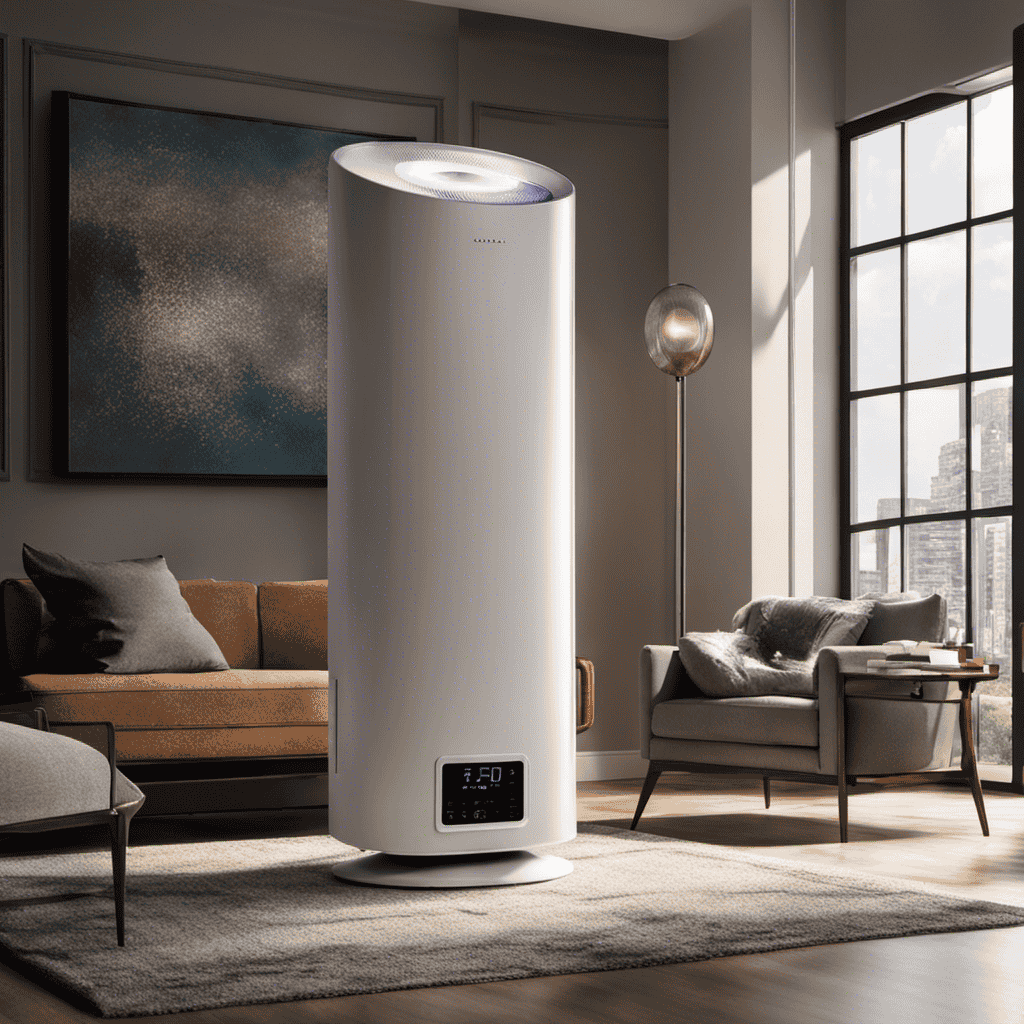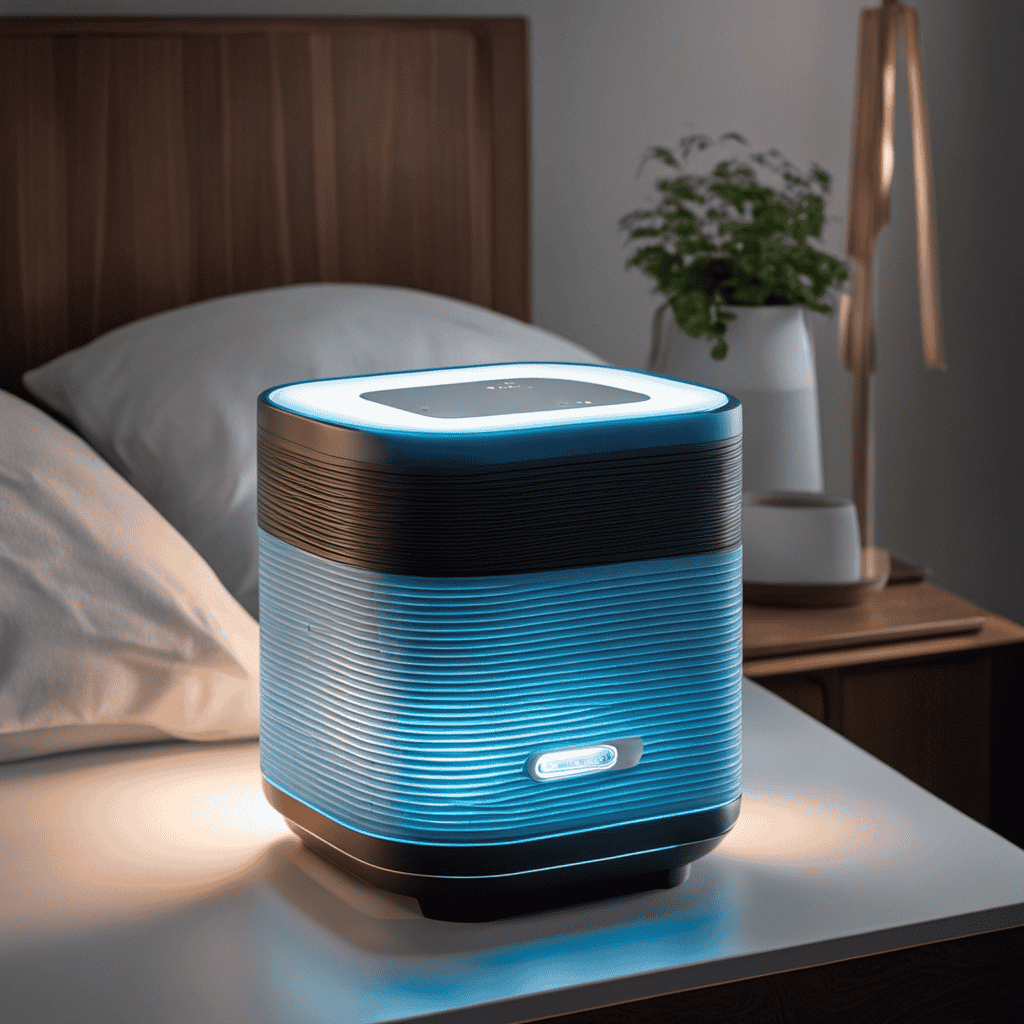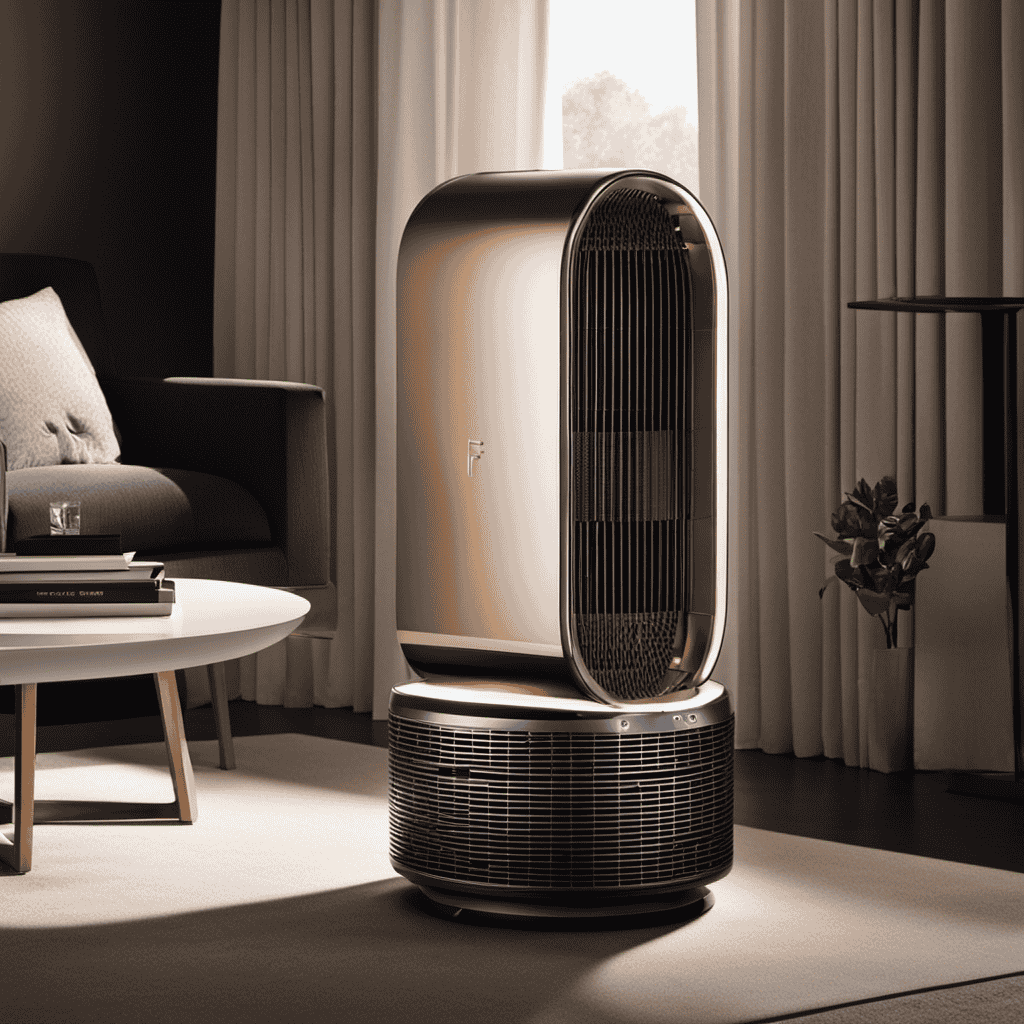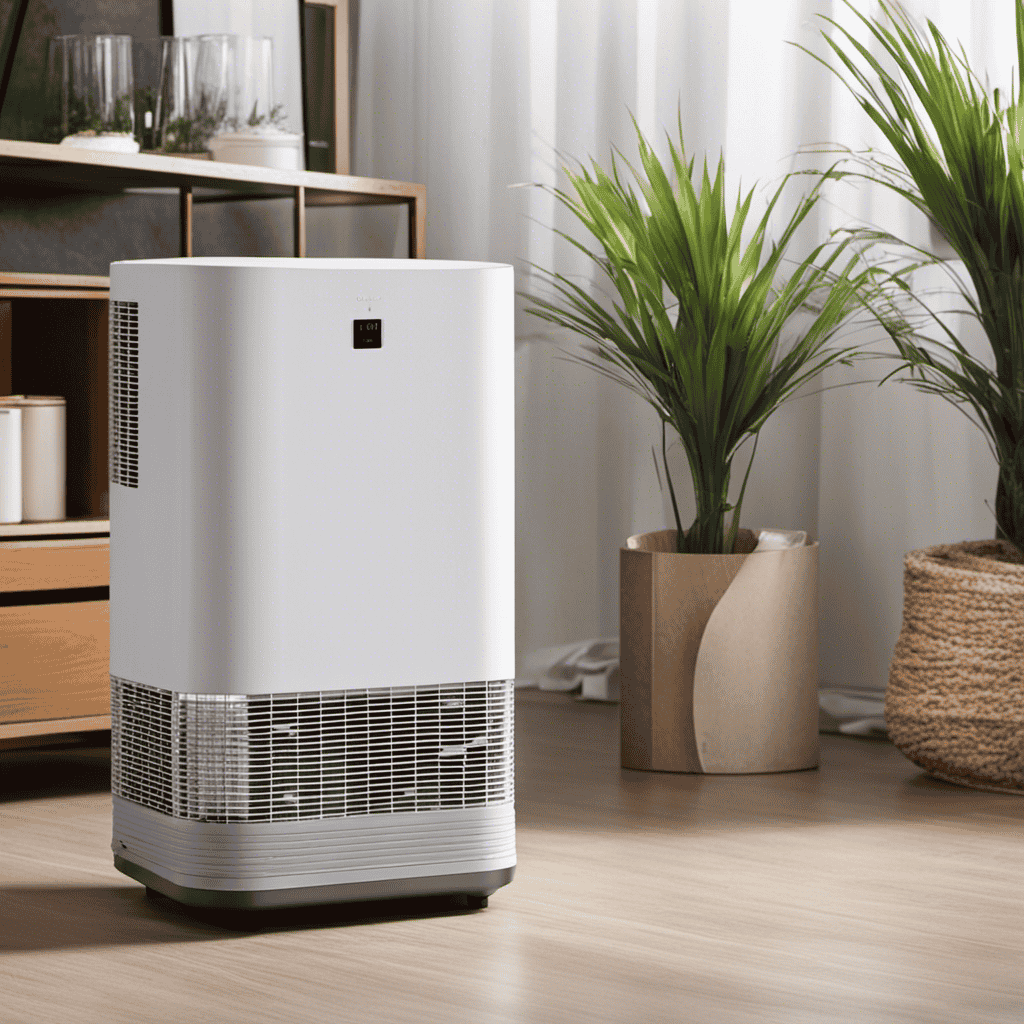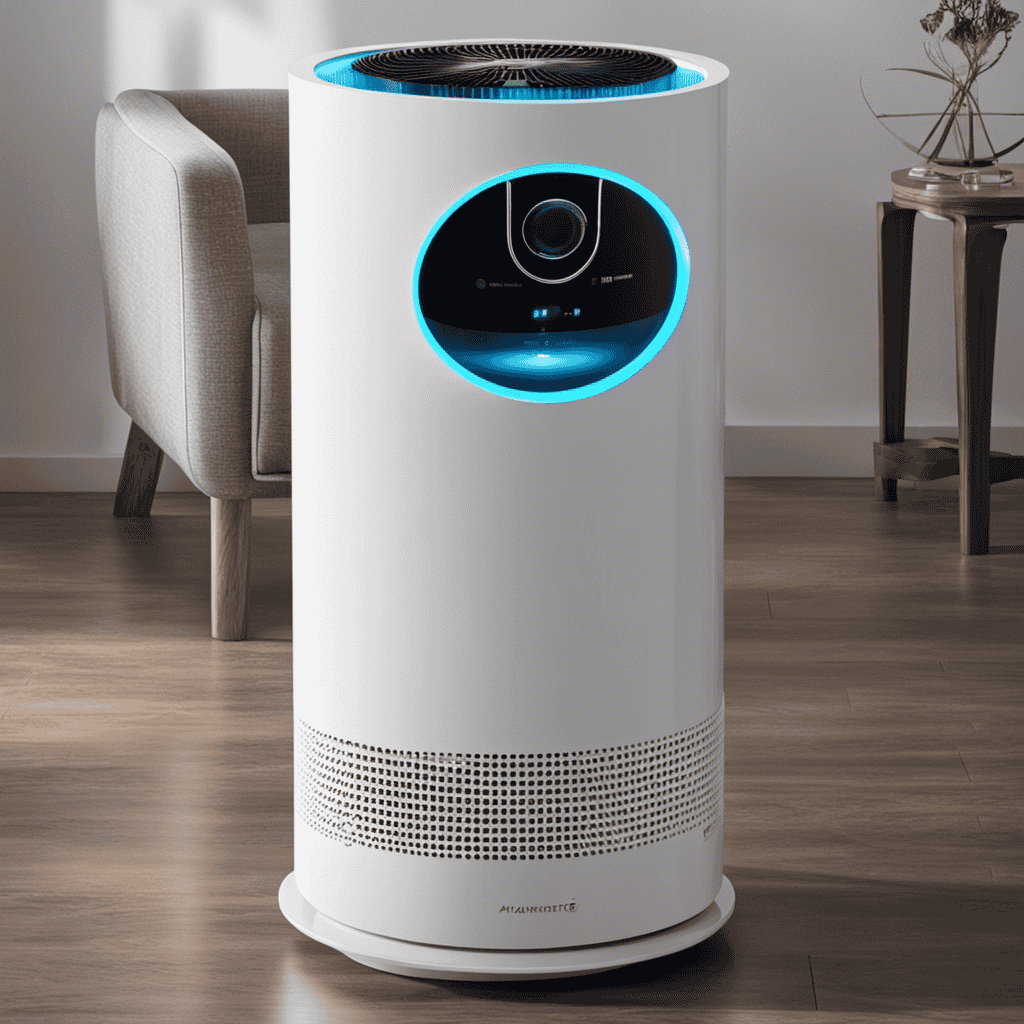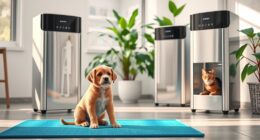As a person who prioritizes clean air in my household, I recognize the significance of taking steps during times of poor air quality. It is essential to consider the harmful pollutants that can affect our well-being and find practical solutions.
That’s where an air purifier comes in. With its ability to remove harmful particles and improve air quality, it becomes a vital tool in creating a healthier living environment.
In this article, we will explore the causes of poor air quality and how an air purifier can help combat it.
Key Takeaways
- Air purifiers can improve indoor air quality by reducing allergens and pollutants.
- They offer benefits such as improved respiratory health and removal of harmful gases.
- Air purifiers can eliminate unpleasant odors and enhance sleep quality.
- Using an air purifier with a HEPA filter leads to cleaner and healthier indoor air.
What Causes Poor Air Quality
Poor air quality can be caused by a variety of factors. Pollution is a major contributor, with emissions from vehicles, factories, and power plants releasing harmful gases and particles into the air. These pollutants, including nitrogen dioxide, sulfur dioxide, and particulate matter, can have detrimental effects on human health and the environment.
Allergens also play a role in poor air quality. Pollen, mold spores, and dust mites are common allergens that can contribute to respiratory issues in susceptible individuals.
The impact of poor air quality on health is significant. Studies have linked it to respiratory diseases, cardiovascular problems, and even premature death. Additionally, it can harm the environment by contributing to climate change and damaging ecosystems.
To improve air quality, there are several solutions. Reducing emissions is crucial, whether through stricter regulations or promoting the use of electric vehicles. Promoting renewable energy sources can also help reduce pollution. Additionally, using air purifiers to filter out pollutants can be beneficial for indoor air quality.
The Importance of Clean Air in Your Home
Air purifiers offer numerous benefits for improving indoor air quality and reducing the presence of allergens and pollutants that can negatively impact our health.
These devices work by filtering out particles such as dust, pollen, pet dander, and mold spores. These substances can trigger allergies and respiratory problems.
Benefits of Air Purifiers
If you’re looking to improve the quality of the air around you, an air purifier can provide you with numerous benefits. Air purifiers are designed to remove pollutants and allergens from the air, resulting in cleaner and healthier indoor environments.
Here are some of the benefits of using an air purifier:
-
Improved respiratory health: Air purifiers can help reduce the presence of airborne particles such as dust, pollen, and pet dander, which can trigger allergies and asthma symptoms.
-
Removal of harmful gases: Certain air purifiers are equipped with activated carbon filters that can effectively remove volatile organic compounds (VOCs) and other harmful gases from the air.
-
Odor elimination: Air purifiers can help eliminate unpleasant odors from cooking, smoking, or pet odors, leaving your indoor space smelling fresh.
-
Enhanced sleep quality: By removing airborne particles and allergens, air purifiers can create a cleaner and more conducive sleeping environment, helping you achieve better sleep.
-
Protection against air pollution: Air purifiers can be particularly beneficial in areas with high levels of outdoor air pollution, providing an extra layer of protection against harmful pollutants.
Investing in an air purifier is a proactive step towards improving the quality of the air you breathe and finding effective solutions to air pollution.
Allergens and Pollutants
To effectively reduce allergens and pollutants in your home, consider using an air purifier equipped with a HEPA filter. HEPA filters, or High Efficiency Particulate Air filters, are designed to capture and trap small particles such as dust, pollen, pet dander, and even some bacteria and viruses. These filters have been proven to be highly effective in improving indoor air quality and reducing allergen exposure.
Many air purifier brands offer models with HEPA filters that are specifically designed for allergen control. These brands include Honeywell, Blueair, and Dyson, among others. By investing in an air purifier with a HEPA filter, you can significantly reduce the presence of allergens and pollutants in your home, leading to cleaner and healthier indoor air.
This is particularly important considering the adverse health effects that can result from prolonged exposure to indoor air pollution.
In the next section, we will explore the various health effects of pollution and how it can negatively impact our well-being.
Health Effects of Pollution
You may experience a range of health effects due to pollution exposure, including respiratory issues, allergies, and cardiovascular problems. These health risks are directly linked to the presence of pollutants in the air we breathe.
The following are some of the main respiratory diseases associated with polluted air:
- Asthma: Pollution can trigger asthma attacks and worsen symptoms in individuals already suffering from the condition.
- Chronic obstructive pulmonary disease (COPD): Long-term exposure to air pollution can contribute to the development and progression of COPD, a group of lung diseases including chronic bronchitis and emphysema.
- Lung cancer: Pollutants such as fine particulate matter and toxic gases can increase the risk of developing lung cancer.
- Allergic rhinitis: Exposure to allergens in the air, such as pollen and mold spores, can lead to nasal congestion, sneezing, and other allergic symptoms.
- Pneumonia: Air pollution can weaken the immune system, making individuals more susceptible to respiratory infections like pneumonia.
These health effects highlight the importance of identifying signs that indicate bad air quality.
Signs That Indicate Bad Air Quality
Feeling lightheaded and experiencing coughing are clear indicators that the air quality is bad.
When it comes to indoor air pollution, there are several common air quality indicators that can help us determine if the air we are breathing is healthy or not.
One of the most common indicators is the presence of strong odors or smells. This could be a sign of chemicals or pollutants in the air.
Another indicator is the presence of excessive dust or dirt particles in the air. These particles can irritate our respiratory system and lead to coughing or sneezing.
Additionally, if you notice an increase in allergy or asthma symptoms, it could be a sign of poor air quality.
These indicators can help us take necessary steps to improve the air we breathe and maintain a healthy indoor environment.
Understanding Air Pollutants and Their Effects
Excessive exposure to pollutants can have detrimental effects on our respiratory system and overall health. It is crucial to understand the sources of air pollution and take steps to reduce indoor air pollutants. Here are some key points to consider:
- Outdoor sources of air pollution include vehicle emissions, industrial activities, and natural sources such as wildfires.
- Indoor sources of air pollution include tobacco smoke, cooking fumes, cleaning products, and building materials.
- Fine particles, nitrogen dioxide, sulfur dioxide, carbon monoxide, and volatile organic compounds are common air pollutants.
- Exposure to air pollutants can lead to respiratory problems, cardiovascular issues, allergies, and even cancer.
- Ventilation, proper household cleaning, and using air purifiers can help reduce indoor air pollutants and improve air quality.
Understanding air pollution sources and taking measures to reduce indoor pollutants are crucial for maintaining a healthy living environment.
Transitioning into the next section, let’s explore how an air purifier can effectively improve air quality.
How an Air Purifier Can Improve Air Quality
Using an air purifier can effectively enhance the quality of the air we breathe in our living environment. Air purification methods and air purifier technology have advanced significantly in recent years, providing us with efficient ways to remove pollutants and improve indoor air quality.
Air purifiers work by utilizing various filtration techniques to capture and eliminate airborne particles, such as dust, pollen, pet dander, and even harmful gases. These devices often incorporate HEPA filters, activated carbon filters, and sometimes even UV-C light technology to effectively remove contaminants from the air.
By utilizing these advanced air purification methods, air purifiers can significantly reduce the presence of indoor air pollutants, leading to a cleaner and healthier living environment.
With the understanding of how air purifiers can improve air quality, it is essential to choose the right air purifier for your needs.
Choosing the Right Air Purifier for Your Needs
When it comes to selecting the right air purifier for your needs, it’s important to consider factors such as the size of the room you want to purify and the specific pollutants you want to target. Here are some key features to look for in an air purifier:
- HEPA filter: This type of filter is highly effective at capturing small particles, including dust, pollen, and pet dander.
- Activated carbon filter: This filter helps to remove odors and chemicals from the air.
- UV-C light: This feature can help kill bacteria and viruses.
- CADR rating: This indicates how quickly an air purifier can clean the air in a room.
- Noise level: Consider the noise level of the air purifier, especially if you plan to use it in a bedroom or office.
Regular maintenance is crucial to keep your air purifier working effectively. This includes cleaning or replacing filters regularly and keeping the unit clean. By properly maintaining your air purifier, you can ensure that it continues to provide clean and healthy air for you and your family.
Now, let’s move on to some tips for using an air purifier effectively.
Tips for Using an Air Purifier Effectively
To get the most out of your air purifier, it’s important to regularly clean or replace the filters and keep the unit free of dust and debris. This will ensure that the air purifier is able to effectively remove pollutants from the air, improving sleep and reducing asthma symptoms. In addition to proper maintenance, there are other strategies you can employ to optimize the performance of your air purifier. For example, placing the unit in the bedroom can help improve sleep quality by reducing the presence of allergens and other irritants in the air. Furthermore, running the air purifier continuously, especially during the night, can provide round-the-clock purification and deliver maximum benefits. By following these tips, you can make the most of your air purifier and enjoy cleaner, healthier indoor air.
| Strategies to Improve Air Purifier Effectiveness |
|---|
| Regularly clean or replace filters |
| Keep unit free of dust and debris |
| Place the unit in the bedroom |
Now, let’s explore other ways to improve indoor air quality.
Other Ways to Improve Indoor Air Quality
Running the air purifier continuously, especially at night, can ensure round-the-clock purification and deliver maximum benefits for improving indoor air quality.
In addition to using an air purifier, there are other ways to further enhance the air quality in your home. Consider implementing the following strategies:
- Reducing humidity levels can help prevent the growth of mold and dust mites, which can contribute to poor air quality.
- Ventilation systems, such as exhaust fans and opening windows, can help bring in fresh outdoor air and remove indoor pollutants.
- Regularly cleaning and vacuuming your home can help eliminate dust, pet dander, and other allergens that can negatively impact air quality.
- Avoid smoking indoors, as secondhand smoke can significantly degrade indoor air quality.
- Using natural cleaning products and minimizing the use of chemical-based products can limit the release of volatile organic compounds (VOCs) into the air.
Taking Action: Steps to Improve Air Quality in Your Home
When it comes to improving indoor air quality, two key points to consider are the use of indoor plants for purification and filtering systems for allergies.
Indoor plants are not only aesthetically pleasing, but they can also help remove harmful pollutants from the air through a process called phytoremediation.
On the other hand, filtering systems specifically designed for allergies can effectively capture and remove allergens such as pollen, dust mites, and pet dander, providing relief for those with respiratory sensitivities.
Indoor Plants for Purification
Did you know that having indoor plants can greatly improve the air quality in your home? Not only do plants add a touch of beauty to your living space, but they also act as natural air purifiers.
Here are some reasons why indoor plants are a great addition to any home:
- Plants release oxygen and absorb carbon dioxide, helping to increase oxygen levels and reduce indoor air pollution.
- Certain plants, such as spider plants and peace lilies, have been proven to remove toxins like formaldehyde and benzene from the air.
- Indoor plants can help to regulate humidity levels, preventing dryness or excessive moisture in the air.
- Taking care of indoor plants can be a fulfilling hobby and a form of stress relief.
- Some of the best air purifier brands, like Dyson and Blueair, offer indoor plants maintenance services to ensure your plants thrive and continue to improve the air quality in your home.
Filtering Systems for Allergies
Using filtering systems with HEPA filters can greatly alleviate allergy symptoms by capturing and trapping airborne allergens such as pollen, dust mites, and pet dander. These filtering mechanisms are designed to remove particles as small as 0.3 microns, ensuring cleaner air for individuals with respiratory conditions. HEPA filters work by using a combination of interception, impaction, and diffusion to capture and retain allergens. The table below illustrates the effectiveness of HEPA filters in removing common allergens from the air:
| Allergen | HEPA Filter Efficiency |
|---|---|
| Pollen | 99.97% |
| Dust Mites | 99.9% |
| Pet Dander | 99.97% |
| Mold Spores | 99.9% |
| Bacteria | 99.97% |
Frequently Asked Questions
What Are the Common Sources of Indoor Air Pollutants?
Indoor air pollutants can come from various sources such as tobacco smoke, household cleaning products, and building materials. Breathing in these pollutants can have detrimental effects on our health, especially when the air quality is poor.
How Does Poor Air Quality Affect Our Health?
Poor air quality can have detrimental effects on our health, particularly on our respiratory system. Exposure to air pollution increases the risk of developing respiratory diseases such as asthma, bronchitis, and even lung cancer.
Can an Air Purifier Completely Eliminate All Air Pollutants?
An air purifier cannot completely eliminate all air pollutants, despite its effectiveness. It has limitations in capturing certain particles and gases. However, it can significantly improve indoor air quality and reduce health risks.
Are There Any Specific Air Purifier Features That Are More Effective in Improving Air Quality?
There are specific features in air purifiers that can effectively improve air quality. Air purifier filters and smart air purifiers are two examples. They help remove pollutants and provide cleaner air.
How Long Should an Air Purifier Be Used to See Noticeable Improvements in Air Quality?
Using an air purifier can improve air quality, but how long it takes to see noticeable improvements depends on various factors. To choose the right purifier, consider room size and filtration type. Regular maintenance and cleaning are essential for optimal performance.
Conclusion
In conclusion, using an air purifier can be a beneficial and effective solution when the air quality is bad. By removing harmful pollutants and improving the overall cleanliness of the air, an air purifier helps create a healthier living environment.
It is important to choose the right purifier for your specific needs and use it effectively. Additionally, implementing other methods to improve indoor air quality, such as proper ventilation and reducing sources of pollution, can further enhance the air we breathe.
Remember, clean air is crucial for our well-being and should be a priority.
